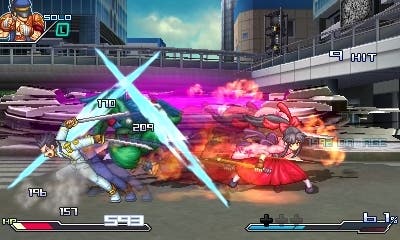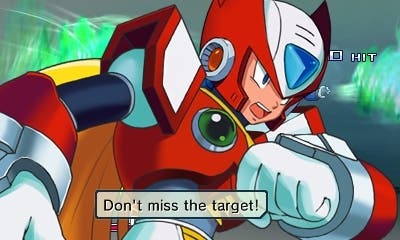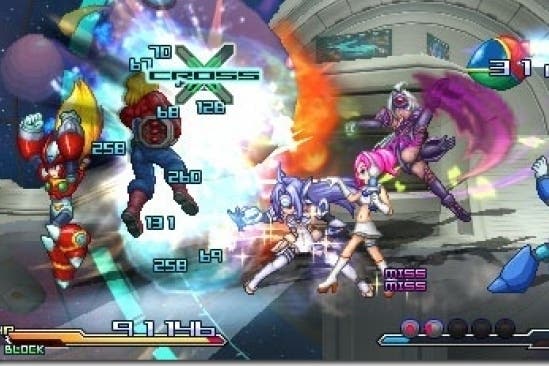Project X Zone review
Clash of heroes.
Combining scores of characters from a range of Japanese video game series, themselves pulled from the back catalogues of three major publishers, tactical RPG Project X Zone is perhaps the best-populated fan service game ever made.
Its multitude of stars are bright and favoured. Where else might you see Colorado's zombie-bothering photo journalist Frank West pull a fire extinguisher from the roomy sleeves of Darkstalkers' Hsien-Ko and then hurl it at V-Dural, the cyborg from Virtua Fighter? Where else might you witness Space Channel 5's aerobics instructor-cum-astronaut Ulala team up with Ghosts 'n Goblins' underpants-wearing Arthur to defeat Resident Evil's alpha-zombie Nemesis? If a fan service game's appeal is the humorous juxtaposition of myths and fictions, Project X Zone is an excellent joke.

But there are also many pitfalls when attempting to shepherd multiple protagonists, antagonists and worlds into a cohesive storyline and, when it comes to plot, Project X Zone falls fully and irredeemably into each. In any story filled with poster boys and girls, each star jostles for attention, straining to communicate all that talent and personality in the few lines of dialogue they're afforded, and Project X Zone is predictably awash with noise and sludgy characterisation. The plot lacks clear goals and obstacles, flitting from location to location without rhyme or reason, and dialogue soon degenerates into a parade of catchphrases and insider gags.
This isn't helped by a workmanlike translation that communicates the raw Japanese text without much of its character or (presumably) original meaning. "This is totally going to depress the retail climate," says one character mournfully following a successful battle in Tokyo's Roppongi district - a punch line without a set-up.
Fortunately, while cut-scenes cannot be skipped, the storyline is afforded little screen time in a game that focuses almost exclusively on the tussle of the frontline. Battles play out on a gridded, chess-like board that's super-imposed onto a series of locations. Characters pair together into attack units and you take turns with the AI to move these teams around the board, attacking enemy units when in range and counterattacking or defending their incoming jabs. Attack an enemy and the view switches to the sideways-on perspective of an orthodox fighting game.
Here you may select one of your team's three basic attacks, each of which send the pair streaking forward, a flurry of arms and legs, to chip away at your enemy's health bar. The end of the assault is usually signalled with a 'launcher', sending your foe high into the air. Time your next move correctly and you can maintain the combo, increasing the amount of damage and winnings post-battle, an emphasis on reaction that's most reminiscent of Street Fighter and other 2D fighters in Capcom's stable.

Each of a team's three basic attacks have a variety of properties attached such as strength, number of hits, XP increase rate and block break strength. As you learn these properties you're able to change the order in which you execute a string of moves more intelligently. Depending on the position of your other units on the field, it's also possible to trigger supporting attacks from nearby friendly units, multiplying the damage you inflict and drastically increasing your combo counter. While the on-field battle tactics are generally far lighter than in Advance Wars and other formative TRPGs, this ability to call in back-up allows for more ambitious players to maximise their efficiency, sharing experience points between various units simultaneously.
Confusingly, Project X Zone uses both the terms XP and EXP to refer to different currencies. 'XP' is the unit of experience won after each successful battle, channelled into your characters, which, at set thresholds, increases their strength and abilities. 'EXP', by contrast, is a form of meter that builds as your team attacks. This meter can be spent on performing a character's most powerful special moves or, alternatively, on countering enemy attacks or using skills when on the field for a lower cost.
Killing an enemy with a powerful special move nets bonus XP after the fight, so there's a certain degree of strategy involved for the player who wants to optimise their gains - saving up EXP, for example, for a devastating final special move to finish a foe. Teams also earn a percentage XP bonus for the maximum number of hits executed in a normal combo and the maximum number of hits in a 'cross' combo, involving a support team.

Despite the seeming complexity of the system, these numbers can by and large be ignored. Fine-detail strategies based on attack properties are possible, but they're rarely necessary for making progress when brute force and persistence is equally effective. Either way, moving your units around the field in a cluster so that no pairing becomes isolated generally guarantees victory. Battles have a kinetic energy - and the screen-filling animations show off the characters in their best light - but in terms of player interaction they are fairly hands-off. Instead it's the spectacle that's intended to carry your interest.
This is problematic when there's next to nothing to do between battles. Enemies drop the occasional piece of status-improving equipment, but there's no shop to purchase better equipment from and there are no new attacks to unlock. Without a coherent storyline, all your motivation must derive from the battles themselves, which, in their lack of variety, fail to inspire you past the first half of the game.
Beneath the hysterical presentation, the frantic battle segments and the skittish storyline, then, Project X Zone is a thin game. The emphasis on fighting game reactions in the battle segments should appeal to genre fans, but these are too simplistic for genuine expression or mastery. Likewise, the tactical elements of positioning and unit movement on the battlefield lack urgency and true significance. The result is a humorous curio, perhaps, but one without the underlying game to adequately serve its stars.

